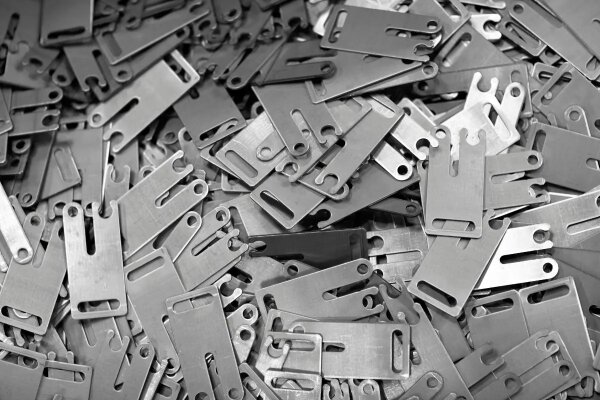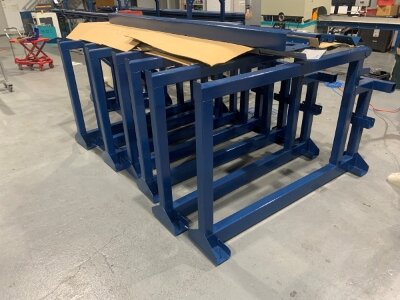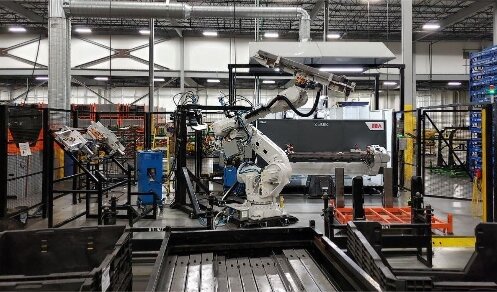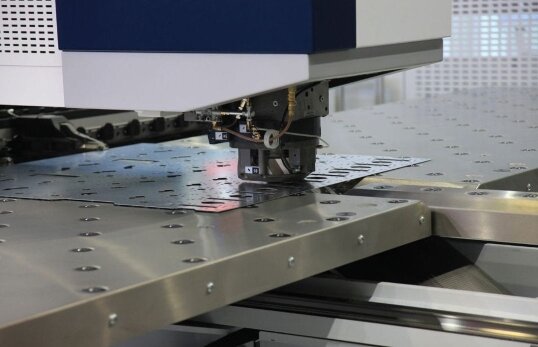Miedź od dawna jest kluczowym materiałem w produkcji ze względu na doskonałą przewodność elektryczną i cieplną. Wraz z rozwojem technologii druku 3D, producenci wykorzystują właściwości miedzi do tworzenia złożonych, wysokowydajnych części. Niniejszy przewodnik przedstawia podstawy, korzyści i zastosowania druku 3D z miedzi.
Co to jest druk 3D w miedzi?
Druk 3D z miedzi to produkcja addytywna, w której proszek lub drut miedziany jest nakładany warstwowo i stapiany w celu zbudowania części. Tradycyjne metody, takie jak odlewanie i obróbka skrawaniem, mają problemy z miedzią, ponieważ jej wysoki współczynnik odbicia i przewodność cieplna sprawiają, że praca z nią jest trudna.
Ostatnie postępy w dziedzinie laserowego i opartego na wytłaczaniu druku 3D zmieniły ten stan rzeczy. Producenci mogą teraz tworzyć szczegółowe części miedziane z dużą dokładnością i wydajnością.
Jak działa druk 3D z miedzi?
Druk 3D z miedzi przekształca cyfrowe projekty w fizyczne części za pomocą produkcji addytywnej. Poniżej przedstawiamy krok po kroku, jak to działa.
Projektowanie modelu 3D
Zacznij od cyfrowego modelu 3D utworzonego za pomocą oprogramowania CAD. Model ten definiuje kształt, rozmiar i cechy części.
Przygotowanie pliku
Model 3D jest dzielony na cienkie warstwy przy użyciu specjalistycznego oprogramowania. W ten sposób powstaje plik, który drukarka 3D może odczytać i wykonać.
Konfiguracja drukarki
Załaduj proszek miedziany lub drut do drukarki 3D. Upewnij się, że platforma robocza jest czysta i odpowiednio skalibrowana, aby zapewnić dokładne drukowanie.
Drukowanie części
Drukarka nakłada lub stapia miedziany materiał warstwa po warstwie. Techniki takie jak selektywne topienie laserowe (SLM) wykorzystują laser do stapiania proszku, podczas gdy bezpośrednie osadzanie energii (DED) topi drut lub proszek podczas jego osadzania.
Przetwarzanie końcowe
Po wydrukowaniu część może wymagać dodatkowych etapów, takich jak obróbka cieplna, polerowanie lub obróbka skrawaniem w celu uzyskania pożądanego wykończenia i właściwości.
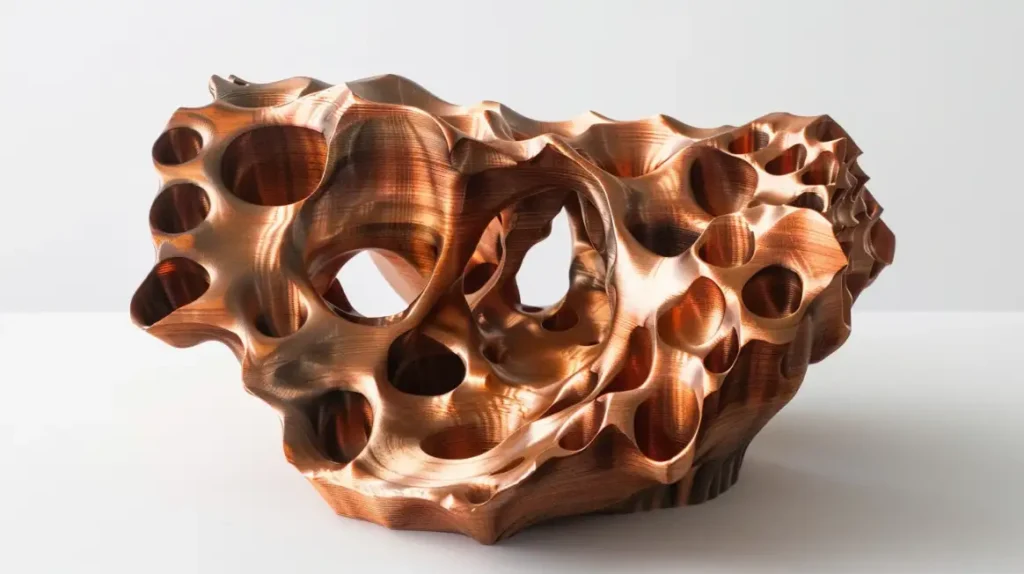
Właściwości miedzi drukowanej w 3D
Drukowane w 3D komponenty miedziane wykazują odmienne właściwości w porównaniu do tradycyjnie wytwarzanej miedzi:
Przewodność cieplna
Doskonała przewodność cieplna miedzi sprawia, że jest ona cenna w zastosowaniach związanych z zarządzaniem ciepłem. Miedź drukowana 3D zazwyczaj osiąga 85-95% przewodności cieplnej miedzi kutej, w zależności od technologii druku i parametrów.
Przewodnictwo elektryczne
Przewodność elektryczna jest kluczową właściwością dla wielu zastosowań miedzi. Obecne technologie druku 3D są w stanie ją osiągnąć:
- DMLS: 80-90% IACS (International Annealed Copper Standard)
- EBM: 85-95% IACS
- BMD: 75-85% IACS
Właściwości mechaniczne
Właściwości mechaniczne miedzi drukowanej w 3D zależą w dużej mierze od porowatości, orientacji wydruku i obróbki końcowej:
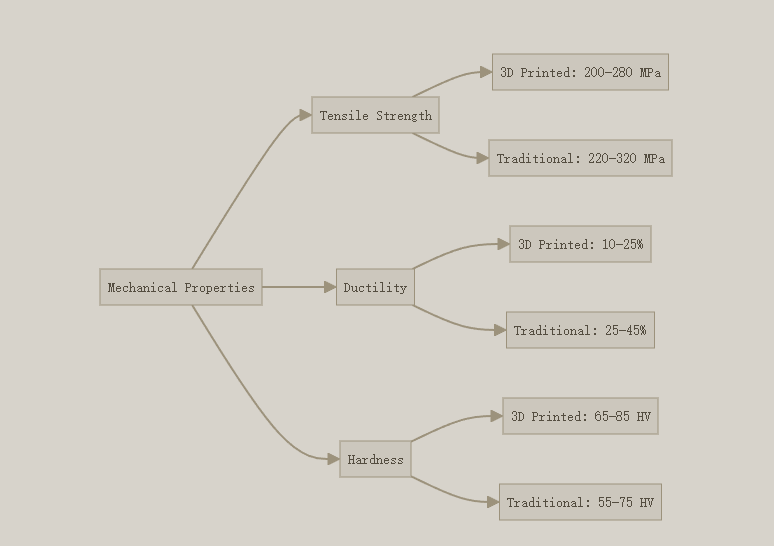
Obecne technologie druku 3D z miedzi
Kilka technologii druku 3D jest kompatybilnych z miedzią. Każda z nich ma unikalne zalety i nadaje się do konkretnych zastosowań.
Bezpośrednie spiekanie laserowe metali (DMLS)
DMLS wykorzystuje laser o dużej mocy do topienia proszku miedzi. Laser podąża za kształtem każdej warstwy w oparciu o model 3D. Po każdej warstwie platforma robocza obniża się, a nowa warstwa proszku rozprzestrzenia się po powierzchni.
DMLS zapewnia wysoką dokładność (±0,1 mm) i może produkować części o gęstości do 99,5%. Proces ten pozwala na tworzenie znacznych części, ale wysoki współczynnik odbicia miedzi utrudnia pochłanianie energii lasera. Nowe zielone i niebieskie lasery pomogły rozwiązać ten problem.
Topienie wiązką elektronów (EBM)
EBM wykorzystuje wiązkę elektronów zamiast lasera do topienia proszku miedzi. Proces odbywa się w próżni, co zapobiega utlenianiu się miedzi.
Wiązka elektronów jest bardziej energooszczędna niż lasery i zmniejsza naprężenia w drukowanych częściach. Zmniejsza to ryzyko wypaczeń i zniekształceń, które są powszechne podczas drukowania miedzi.
Wiązane osadzanie metalu (BMD)
BMD wykorzystuje cząstki miedzi zmieszane ze spoiwem polimerowym. Materiał jest przepychany przez dyszę, podobnie jak w druku FDM. Po wydrukowaniu część przechodzi przez etap usuwania polimeru, a następnie spiekania w celu stopienia cząstek miedzi.
BMD ma pewne zalety. Sprzęt jest tańszy, łatwiejszy w użyciu i bezpieczniejszy, ponieważ nie wymaga luźnego proszku metalowego. Jednak podczas spiekania części kurczą się o 15-20%, co należy uwzględnić w procesie projektowania.
Natryskiwanie spoiwa
Binder jetting polega na rozpylaniu ciekłego spoiwa na podłoże z proszku miedzi. Głowica drukująca przesuwa się po powierzchni, dodając spoiwo tam, gdzie jest to potrzebne. Po każdej warstwie platforma obniża się i rozprowadzana jest nowa warstwa proszku.
Wydrukowana część, zwana "zieloną", musi zostać poddana spiekaniu w celu stopienia miedzi. Metoda ta jest szybsza niż drukowanie laserem lub wiązką elektronów i pozwala na jednoczesną produkcję wielu części.
| Technologia | Rozdzielczość | Gęstość materiału | Wykończenie powierzchni | Koszt | Prędkość | Złożoność Zdolność |
|---|---|---|---|---|---|---|
| DMLS | Wysoki (±0,05 mm) | 97-99% | Dobry | Wysoki | Umiarkowany | Doskonały |
| EBM | Średni (±0,1 mm) | >99,5% | Sprawiedliwy | Bardzo wysoka | Szybko | Bardzo dobry |
| BMD | Średni (±0,1 mm) | 95-98% | Sprawiedliwy | Umiarkowany | Powolny | Dobry |
| Natryskiwanie spoiwa | Średni (±0,1 mm) | 92-97% | Sprawiedliwy | Umiarkowany | Bardzo szybki | Dobry |
Zastosowania druku 3D z miedzi
Druk 3D z miedzi przekształca branże, umożliwiając produkcję wcześniej trudnych lub niemożliwych do wyprodukowania części. Poniżej przedstawiamy kilka kluczowych zastosowań:
| Przemysł | Aplikacja | Korzyści |
|---|---|---|
| Elektronika | Płytki drukowane, złącza i anteny | Wysoka przewodność elektryczna i elastyczność projektowania. |
| Lotnictwo i kosmonautyka | Wymienniki ciepła i systemy chłodzenia | Lekkość, złożona geometria i wydajne zarządzanie temperaturą. |
| Medyczny | Antybakteryjne implanty i narzędzia | Odporność na korozję i biokompatybilność. |
| Motoryzacja | Komponenty do pojazdów elektrycznych | Ulepszone zarządzanie termiczne i zmniejszona waga. |
| Energia | Radiatory i komponenty paneli słonecznych | Zwiększona przewodność cieplna i trwałość. |
Korzyści płynące z druku 3D z miedzi
Druk 3D z miedzi ma wiele zalet, dzięki czemu jest cennym narzędziem dla inżynierów, projektantów i producentów. Przyjrzyjmy się bliżej jego kluczowym zaletom.
Swoboda projektowania
Druk 3D pozwala na uzyskanie złożonych geometrii, których nie można osiągnąć tradycyjnymi metodami. Można tworzyć skomplikowane struktury wewnętrzne, lekkie konstrukcje i niestandardowe kształty dostosowane do konkretnych potrzeb. Ta elastyczność otwiera nowe możliwości dla innowacji.
Wydajność materiałowa
Produkcja addytywna wykorzystuje tylko materiał potrzebny do zbudowania części, zmniejszając ilość odpadów. W przeciwieństwie do metod subtraktywnych, które odcinają nadmiar materiału, druk 3D dodaje materiał warstwa po warstwie, co czyni go bardziej zrównoważoną opcją.
Oszczędności
Chociaż początkowa konfiguracja może być kosztowna, drukowanie 3D często zmniejsza koszty w dłuższej perspektywie. Eliminuje potrzebę kosztownego oprzyrządowania i form, zwłaszcza w przypadku prototypy I Produkcja małoseryjna. Przyspiesza również cykl od projektu do produkcji.
Wydajność
Doskonała przewodność cieplna i elektryczna miedzi zwiększa wydajność drukowanych w 3D części. Niezależnie od tego, czy jest to wymiennik ciepła, komponent elektryczny czy niestandardowe narzędzie, druk 3D z miedzi zapewnia trwałe i wydajne rezultaty.
Wyzwania i rozważania
Druk 3D z miedzi oferuje wiele korzyści, ale wiąże się również z wyjątkowymi wyzwaniami. Ich zrozumienie może pomóc w planowaniu i optymalizacji projektów.
Wysoki współczynnik odbicia
Odblaskowa natura miedzi utrudnia laserom równomierne topienie proszku. Może to prowadzić do nierównomiernego topienia i wpływać na jakość końcowej części. Aby rozwiązać ten problem, często potrzebny jest specjalistyczny sprzęt i precyzyjne ustawienia lasera.
Przewodność cieplna
Wysoka przewodność cieplna miedzi może być zarówno zaletą, jak i wyzwaniem. Chociaż świetnie nadaje się do zarządzania ciepłem, oznacza to również, że ciepło szybko rozprasza się podczas drukowania, co utrudnia utrzymanie odpowiedniej temperatury dla prawidłowego połączenia warstw.
Utlenianie
Miedź szybko utlenia się pod wpływem powietrza, osłabiając część i wpływając na jakość jej powierzchni. Drukowanie w środowisku gazu obojętnego, takiego jak argon lub azot, pomaga zapobiegać utlenianiu i zapewnia lepsze wyniki.
Wymagania dotyczące przetwarzania końcowego
Po wydrukowaniu części miedziane często wymagają dodatkowych czynności, takich jak obróbka cieplna, polerowanielub obróbka skrawaniem. Procesy te poprawiają wytrzymałość części, wykończenie powierzchni i ogólną jakość, ale zwiększają czas i koszty cyklu produkcyjnego.
Wnioski
Druk 3D miedzi zmienił produkcję, umożliwiając większą swobodę projektowania i lepszą wydajność. Choć nadal istnieją wyzwania, nowe technologie sprawiają, że proces ten staje się bardziej praktyczny w większej liczbie zastosowań.
W Shengen jesteśmy zaangażowani w oferowanie kompletnych rozwiązań produkcyjnych. Łączymy zaawansowane technologie, takie jak miedziany druk 3D, z naszym doświadczeniem w produkcji blach, aby zaspokoić potrzeby naszych klientów.
Jeśli chcesz wykorzystać zalety druku 3D z miedzi, jesteśmy tutaj, aby Ci pomóc. Skontaktuj się z nami Skontaktuj się z nami już dziś, aby omówić swoje potrzeby i dowiedzieć się, w jaki sposób możemy wprowadzić Twoje projekty w życie z precyzją i wydajnością.
FAQ: Druk 3D z miedzi
Jaka jest różnica w kosztach między miedzią drukowaną w 3D a miedzią produkowaną w tradycyjny sposób?
Miedź drukowana w 3D kosztuje zazwyczaj 3-5 razy więcej na jednostkę objętości niż miedź wytwarzana tradycyjnie. Jednak ta różnica w kosztach znacznie spada w przypadku złożonych geometrii, gdzie tradycyjna produkcja wymagałaby wielu operacji lub etapów montażu.
Jaki jest największy możliwy rozmiar drukowanych w 3D części miedzianych?
Obecne systemy komercyjne oferują rozmiary od 250×250×250 mm do 500×500×500 mm. Większe części są możliwe dzięki łączeniu wielu drukowanych sekcji.
Jak wypada przewodnictwo miedzi wydrukowanej w 3D w porównaniu z tradycyjną miedzią?
Większość miedzi drukowanej w 3D osiąga 80-95% przewodności elektrycznej miedzi kutej, w zależności od technologii druku, parametrów i obróbki końcowej.
Czy miedź drukowana w 3D może być wykorzystywana w zastosowaniach wysokotemperaturowych?
Tak, miedź drukowana w 3D zachowuje doskonałe właściwości w podwyższonych temperaturach, dzięki czemu nadaje się do zastosowań działających w temperaturach do 800°C, w zależności od konkretnego stopu i metody produkcji.
Jaka obróbka końcowa jest zazwyczaj wymagana w przypadku miedzi drukowanej w 3D?
Typowe etapy obróbki końcowej obejmują obróbkę cieplną w celu zmniejszenia naprężeń wewnętrznych, prasowanie izostatyczne na gorąco w celu zmniejszenia porowatości, wykończenie powierzchni w celu poprawy przewodności oraz obróbkę skrawaniem w celu uzyskania krytycznych wymiarów lub cech.
Hej, jestem Kevin Lee

Przez ostatnie 10 lat byłem zanurzony w różnych formach produkcji blach, dzieląc się tutaj fajnymi spostrzeżeniami z moich doświadczeń w różnych warsztatach.
Skontaktuj się z nami

Kevin Lee
Mam ponad dziesięcioletnie doświadczenie zawodowe w produkcji blach, specjalizując się w cięciu laserowym, gięciu, spawaniu i technikach obróbki powierzchni. Jako dyrektor techniczny w Shengen, jestem zaangażowany w rozwiązywanie złożonych wyzwań produkcyjnych i napędzanie innowacji i jakości w każdym projekcie.

